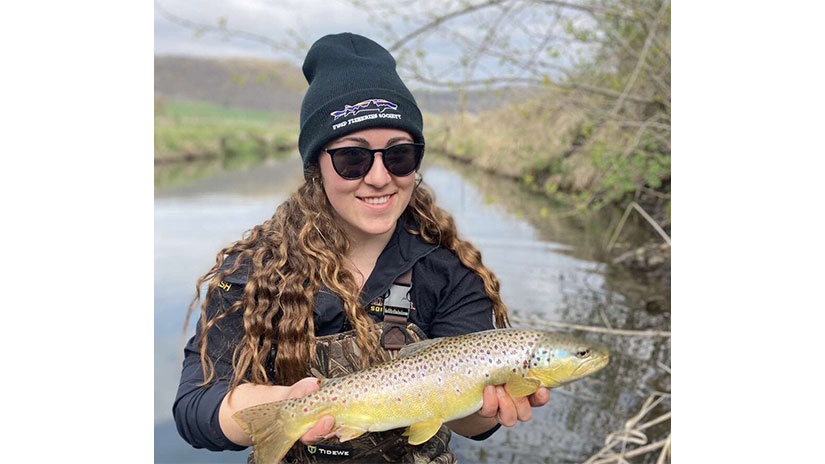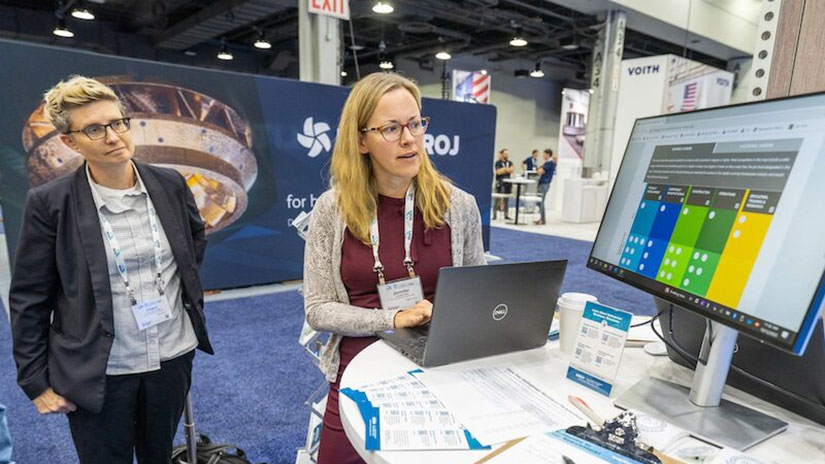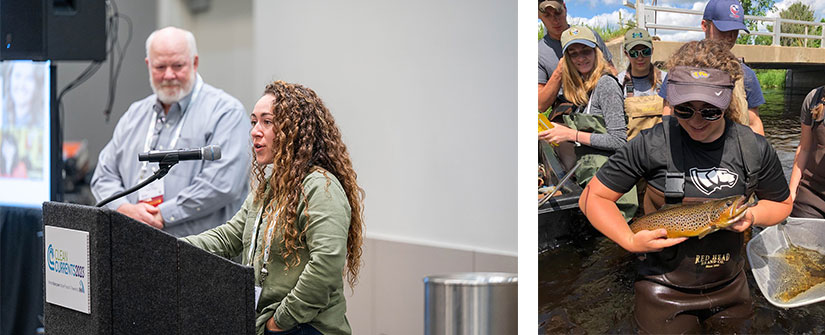Curious About a Climate Career? Don’t Forget Water Power.
New Hydropower and Marine Energy Career Maps Offer Practical Pathways for Anyone To Pursue a Wide Range of Well-Paying, Planet-Saving Jobs

With two new water power career maps, graduate students like Natalie Coash can easily learn how their degrees in fisheries, construction, law, and more could land them jobs in the clean hydropower and marine energy industries. Photo from Natalie Coash
Natalie Coash knows fish. She studied brook trout in Wisconsin’s Little Plover River, monitored salmon populations in Alaska’s Cook Inlet, and now models fishing impacts on Alabama’s black bass.
But until recently, Coash did not know her aquatic expertise could land her a job in what might seem like a not-so-fishy industry: clean, renewable water power.
“Back in undergrad,” said Coash, who is now a graduate student at Auburn University in Alabama, “I was applying all over the place for summer internships and was completely blind to the number of opportunities in the hydropower industry.”
Coash is not alone. Few high schools, colleges, and universities include hydropower—or its water power counterpart, marine energy—in their career centers or fairs. Many students are often unfamiliar with the careers available in these growing industries. And, with so many potential career paths to promote, it is unfair to put that responsibility on schools and teachers anyway.
That is why the U.S. Department of Energy’s (DOE's) Water Power Technologies Office (WPTO), along with water power researchers from the National Renewable Energy Laboratory (NREL), just published two new career maps for hydropower and marine energy. These are the two newest additions to a larger DOE project called “Map a Career in Clean Energy.” To fight the climate crisis and bring clean energy technologies to communities across the United States, the country needs help—it needs more workers. And those future workers—which include high school, undergraduate, and graduate students as well as skilled workers hoping to switch career paths—need help, too.
Now, with DOE’s new career maps, these future climate-change fighters can easily identify practical pathways to a wide range of well-paying jobs in hydropower, marine energy, manufacturing, green buildings, wind and solar energy, and more.
The Country Needs a Robust Water Power Workforce To Transition to Clean Energy
For the hydropower and marine energy industries, this career map initiative is especially timely. Both face potential workforce crises that could hamper the country’s transition to clean energy.

NREL’s Jennifer Daw (right) demonstrated the new hydropower career map to Chaun McQueen of Bonneville Environmental Foundation at this year’s Clean Currents conference, which brings together the wide world of water power industry and workers. Photo by Werner Slocum, NREL
“The hydropower workforce pipeline needs to be strengthened,” said Jennifer Daw, a senior researcher and group manager at NREL, who helped build the new career maps.
More than a quarter of the hydropower industry will reach retirement age in the coming years. This so-called silver tsunami could cost the industry not only workers but also the knowledge they have amassed over decades of work. Those losses could make it harder for hydropower to play its key role in a future clean energy power system.
Marine energy faces a different problem: The younger and less-well-known industry is likely to grow in the coming decades. And while budding marine energy technologies could also help provide reliable energy to the U.S. power grid as well as to offshore technologies, like sensors used to monitor the ocean, they are still at an early stage of development. The industry will need new workers and new ideas to get these technologies into the climate fight.
Even if millennials and members of Generation Z are highly likely to pursue climate-related careers, water power is often an overlooked—or invisible—realm, even within renewable energy.
“Younger generations are motivated to have their work make a difference in areas like climate change and sustainability,” Daw said. “These new career maps can help raise the visibility of water power jobs and help job seekers understand how a career in water power can help them effect change.”
How Job Diversity Could Improve Workforce Diversity
The hydropower and marine energy career maps each contain 40 different types of job opportunities for folks with diverse education levels and backgrounds. They are also designed to show how varied water power jobs can be. Each offers pathways for future workers to join the industries as welders, professors, software developers, surveyors, naval architects, lawyers, modelers, harbor workers, environmental scientists, electricians, deck hands, construction workers, divers, civil engineers, cybersecurity specialists, and more.
And yes, there is also ample space for students, like Coash, who study fish and aquatic systems.
“I was never exposed to these job opportunities or internships in high school or during my bachelor’s or master’s degree in fisheries—until now,” Coash said. “I was surprised at the amount of work that these industries are conducting for fish passage—something I assumed was mostly left to academia or state or federal agencies.”
Fish passage—technologies that give migratory fish safe channels to move through hydropower facilities—is just one solution biologists and other environmentally minded workers can develop for the hydropower industry. Facilities also rely on experts to monitor water quality, sediment flows, and ecosystem health, plan ways to restore habitats, and invent new, more sustainable materials to build future plants.
“This tool can take young adults from ‘I want to work in hydropower’ to practical opportunities, job titles, and details that align with their interests and the lifestyles they want to pursue,” Coash said.

Natalie Coash, who also recently attended and presented at the Clean Currents conference, hopes to pursue a career studying fish passage and salmon spawning grounds—blending her love for both salmon and clean hydropower. Photos from Natalie Coash
“Both industries could provide excellent career paths for people with a wide range of skills and abilities, from community college and trade schools to people with advanced degrees. There is a home for everyone in water power,” Daw said. “But students and other job seekers are not aware of these careers and are therefore not pursuing them. Our goal is to help people see themselves in the water power industry.”
Too Many Right Choices
Students like Coash could help a new generation wade into this water-powered world. After she graduates, she plans to return to cold water fisheries, like the one she worked for in Alaska. “My heart is in the salmon industry, and salmon and hydropower can go hand in hand,” Coash said. She hopes to research salmon spawning habitats and identify critical river and stream spawning grounds that future hydropower facilities should avoid.
“Building my career path was more challenging than I thought,” Coash said, partly because there were too many “right choices” to choose from. “Instead of wondering which opportunity is best,” she continued, “I’ve learned that all the opportunities I’m chasing will be valuable tools in my toolkit.”
Thanks to the career maps, Coash now has two more valuable tools to lean on.
Discover all the ways NREL’s experts are inspiring the next generation of clean energy champions to save the planet. Or inspire yourself by visiting our hydropower and marine energy Science, Technology, Engineering, and Mathematics (STEM) portals where you can find networking and job opportunities, curricula and training materials, and day-in-the life videos.
Subscribe to the NREL water power newsletter, The Current, for the latest news on NREL's water power research.
This article has been updated to reflect an editorial change made after its original publication.

